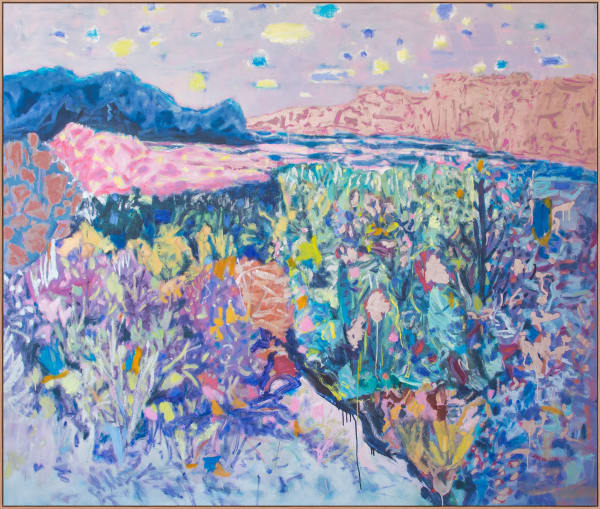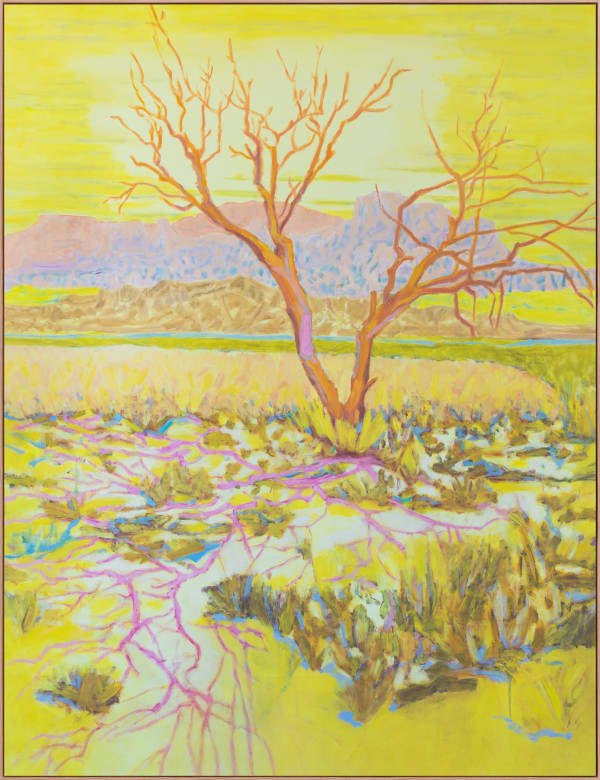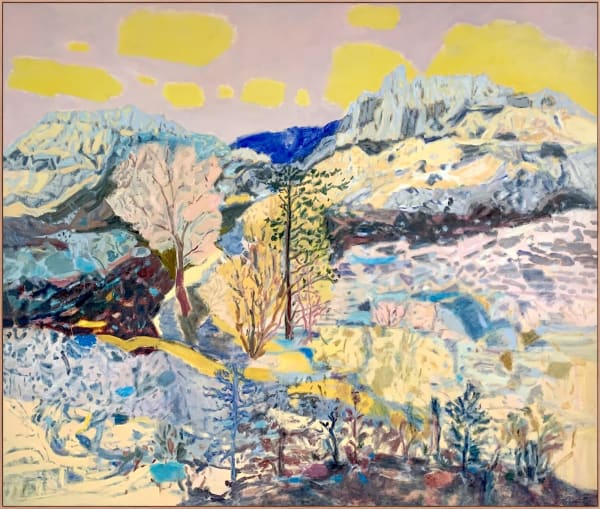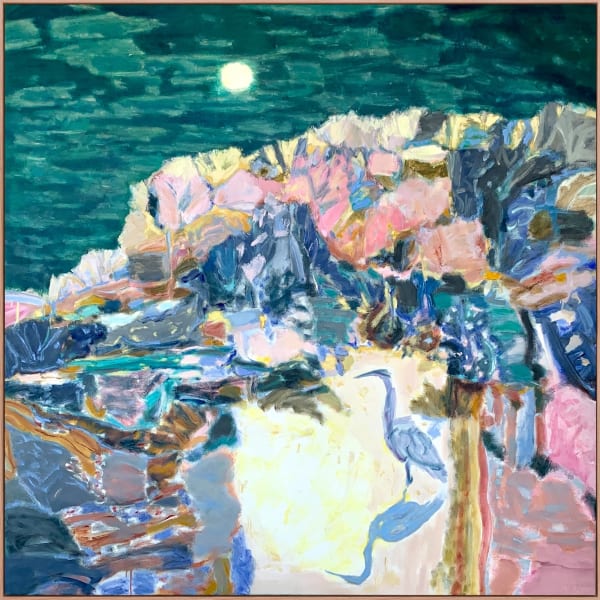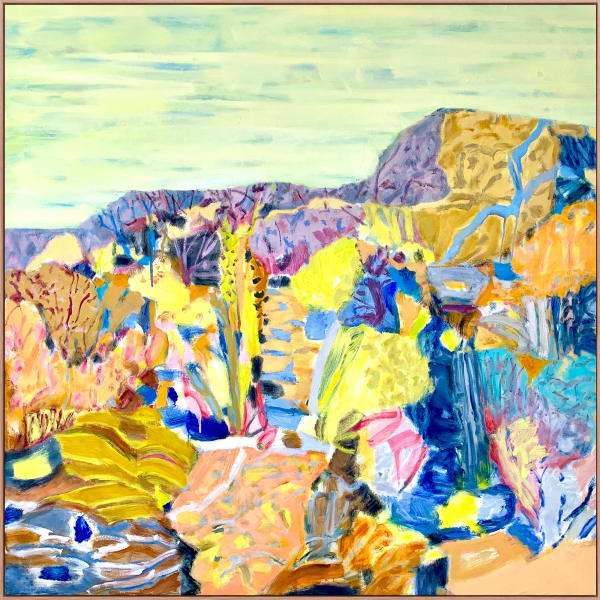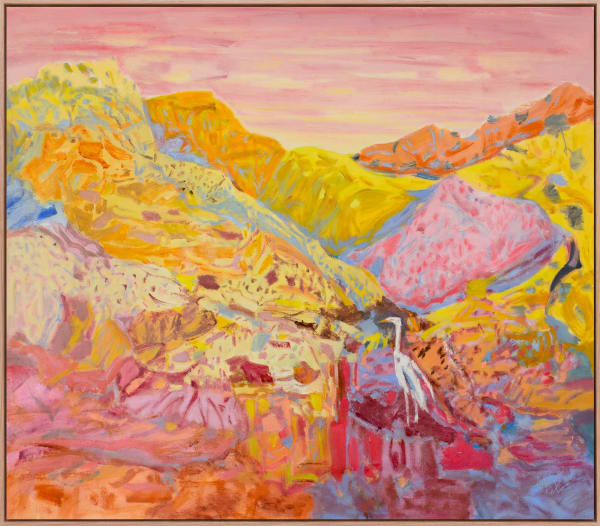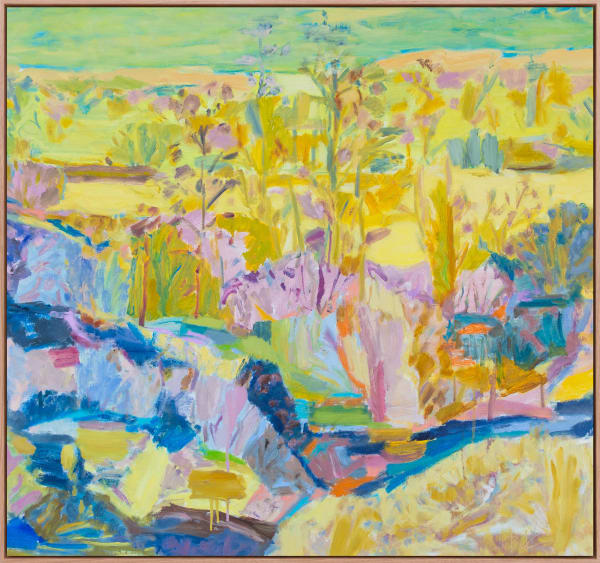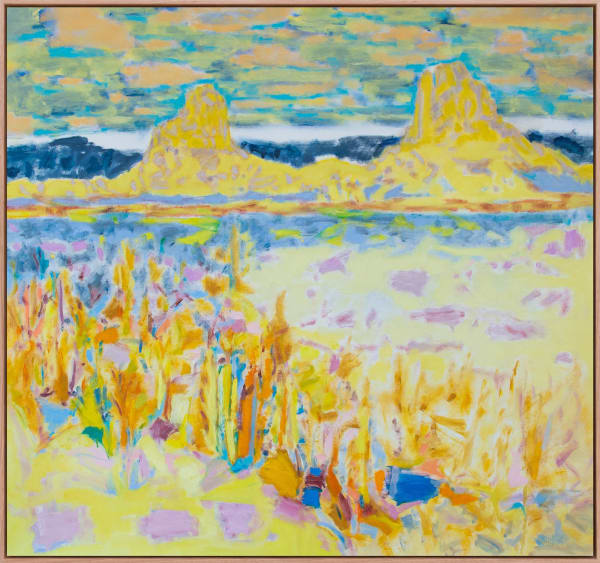Jo Bertini: Deep in Land
-
 Jo BertiniBreath of the Last Wild River, 2022iridescent pigments & oil on French polyester canvas200 x 200 cm, 203.5 x 203.5 cm (framed)Sold
Jo BertiniBreath of the Last Wild River, 2022iridescent pigments & oil on French polyester canvas200 x 200 cm, 203.5 x 203.5 cm (framed)Sold -
 Jo BertiniDark Sky Park Approaching Nowhere, 2022oil on French polyester canvas193 x 203 cm, 195.5 x 205.5 cm (framed)Sold
Jo BertiniDark Sky Park Approaching Nowhere, 2022oil on French polyester canvas193 x 203 cm, 195.5 x 205.5 cm (framed)Sold -
 Jo BertiniA Geography of Mythologies and Lost Little Histories, 2021oil on French polyester canvas200.5 x 203.5 cm, 203 x 206 cm (framed)
Jo BertiniA Geography of Mythologies and Lost Little Histories, 2021oil on French polyester canvas200.5 x 203.5 cm, 203 x 206 cm (framed) -
 Jo BertiniFever Trees, 2021iridescent pigments & oil on French polyester canvas163.5 x 202 cm, 165.5 x 204.5 cm (framed)
Jo BertiniFever Trees, 2021iridescent pigments & oil on French polyester canvas163.5 x 202 cm, 165.5 x 204.5 cm (framed) -
 Jo BertiniWayfinding, 2022oil on French polyester canvas167.5 x 202 cm, 170 x 204.5 cm (framed)
Jo BertiniWayfinding, 2022oil on French polyester canvas167.5 x 202 cm, 170 x 204.5 cm (framed) -
 Jo BertiniSalt Creep Telling Stories, 2021iridescent pigments & oil on French polyester canvas167.5 x 202 cm, 170 x 204.5 cm (framed)Sold
Jo BertiniSalt Creep Telling Stories, 2021iridescent pigments & oil on French polyester canvas167.5 x 202 cm, 170 x 204.5 cm (framed)Sold -
 Jo BertiniDryland Reef, 2021iridescent pigments & oil on French polyester canvas202 x 152 cm, 204.5 x 154.5 cm (framed)Sold
Jo BertiniDryland Reef, 2021iridescent pigments & oil on French polyester canvas202 x 152 cm, 204.5 x 154.5 cm (framed)Sold -
 Jo BertiniTracing Red Jasper – Water Witching and Spirit Stones, 2021iridescent pigments & oil on French polyester canvas152.5 x 152.5 cm, 155 x 155 cm (framed)Sold
Jo BertiniTracing Red Jasper – Water Witching and Spirit Stones, 2021iridescent pigments & oil on French polyester canvas152.5 x 152.5 cm, 155 x 155 cm (framed)Sold -
 Jo BertiniScar Tree – ‘the love of man is a weed of the waste places’ – Randolph Stow, 2021iridescent pigments & oil on French polyester canvas202 x 150 cm, 205 x 152.5 cm (framed)Sold
Jo BertiniScar Tree – ‘the love of man is a weed of the waste places’ – Randolph Stow, 2021iridescent pigments & oil on French polyester canvas202 x 150 cm, 205 x 152.5 cm (framed)Sold -
 Jo BertiniConversations with Clouds, 2022iridescent pigments & oil on Belgian linen155 x 202 cm, 157.5 x 204.5 cm (framed)
Jo BertiniConversations with Clouds, 2022iridescent pigments & oil on Belgian linen155 x 202 cm, 157.5 x 204.5 cm (framed) -
 Jo BertiniThe Water Tree of Doubtful Creek, 2022iridescent pigments & oil on French polyester canvas207.5 x 207.5 cm, 210 x 210 cm (framed)
Jo BertiniThe Water Tree of Doubtful Creek, 2022iridescent pigments & oil on French polyester canvas207.5 x 207.5 cm, 210 x 210 cm (framed) -
 Jo BertiniLuring Bitter Clouds, 2022oil on French polyester canvas167.5 x 202 cm, 169.5 x 204.5 cm (framed)
Jo BertiniLuring Bitter Clouds, 2022oil on French polyester canvas167.5 x 202 cm, 169.5 x 204.5 cm (framed) -
 Jo BertiniLast Light Side Slipping, 2022oil on canvas122 x 122 cm, 124.5 x 124.5 cm (framed)Sold
Jo BertiniLast Light Side Slipping, 2022oil on canvas122 x 122 cm, 124.5 x 124.5 cm (framed)Sold -
 Jo BertiniNight Heron Water Witching, 2022iridescent pigments & oil on French polyester canvas142.5 x 147.5 cm, 145 x 150 cm (framed)Sold
Jo BertiniNight Heron Water Witching, 2022iridescent pigments & oil on French polyester canvas142.5 x 147.5 cm, 145 x 150 cm (framed)Sold -
 Jo BertiniObsidian Seeds (Black Stars) and Smokey Quartz Trails, 2022oil on French polyester canvas122 x 122 cm
Jo BertiniObsidian Seeds (Black Stars) and Smokey Quartz Trails, 2022oil on French polyester canvas122 x 122 cm -
 Jo BertiniThe Beguiled Garden, 2022iridescent pigments & oil on French polyester canvas121.5 x 91.5 cm, 124 x 93.5 cm (framed)Sold
Jo BertiniThe Beguiled Garden, 2022iridescent pigments & oil on French polyester canvas121.5 x 91.5 cm, 124 x 93.5 cm (framed)Sold -
 Jo BertiniDry Waterfall in the Land of Little Rain, 2022oil on Belgian linen156 x 177.5 cm, 158.5 x 179.5 cm (framed)Sold
Jo BertiniDry Waterfall in the Land of Little Rain, 2022oil on Belgian linen156 x 177.5 cm, 158.5 x 179.5 cm (framed)Sold -
 Jo BertiniA Stones Throw Beneath the River, 2022oil on Belgian linen122 x 91.5 cm, 124.5 x 94 cm (framed)Sold
Jo BertiniA Stones Throw Beneath the River, 2022oil on Belgian linen122 x 91.5 cm, 124.5 x 94 cm (framed)Sold -
 Jo BertiniOutlier in a Season of Sand, 2022oil on Belgian linen81.5 x 96.5 cm, 84 x 99 cm (framed)Sold
Jo BertiniOutlier in a Season of Sand, 2022oil on Belgian linen81.5 x 96.5 cm, 84 x 99 cm (framed)Sold -
 Jo BertiniBasin of Indifference, 2020oil on French polyester canvas96.5 x 101.5 cm, 99 x 104 cm (framed)Sold
Jo BertiniBasin of Indifference, 2020oil on French polyester canvas96.5 x 101.5 cm, 99 x 104 cm (framed)Sold -
 Jo BertiniWildflowers Shapeshifting to a Harvest Moon, 2022iridescent pigments & oil on Belgian linen81.5 x 96.5 cm, 84 x 99 cm (framed)Sold
Jo BertiniWildflowers Shapeshifting to a Harvest Moon, 2022iridescent pigments & oil on Belgian linen81.5 x 96.5 cm, 84 x 99 cm (framed)Sold -
 Jo BertiniHunting for Darkness, 2022iridescent pigments & oil on French polyester canvas96.5 x 102 cm, 99 x 104.5 cm (framed)Sold
Jo BertiniHunting for Darkness, 2022iridescent pigments & oil on French polyester canvas96.5 x 102 cm, 99 x 104.5 cm (framed)Sold -
 Jo BertiniSaguaro Creek in Hollow Land, 2021oil on French polyester canvas89.5 x 91.5 cm, 92 x 94 cm (framed)Sold
Jo BertiniSaguaro Creek in Hollow Land, 2021oil on French polyester canvas89.5 x 91.5 cm, 92 x 94 cm (framed)Sold -
 Jo BertiniTwo Boys Dreaming, 2021iridescent pigments & oil on Belgian linen96.5 x 101.5 cm, 99 x 104 cm (framed)Sold
Jo BertiniTwo Boys Dreaming, 2021iridescent pigments & oil on Belgian linen96.5 x 101.5 cm, 99 x 104 cm (framed)Sold -
 Jo BertiniBlood Moon Birthing Tree, 2022oil on Belgian linen96.5 x 96.5 cm, 99 x 99 cm (framed)Sold
Jo BertiniBlood Moon Birthing Tree, 2022oil on Belgian linen96.5 x 96.5 cm, 99 x 99 cm (framed)Sold
Creating art is arguably a form of magic. In the work of Jo Bertini, one can plainly see an alchemy and interplay of paint, surface, pigment, pressure, line, shape, contour, space, and light. Her decades of painting deserts, considered both a mystical and forbidding environment, are distilled in this newest body of work inspired by the high desert areas of northern New Mexico. To experience the works in ‘Deep in Land’ is to see this often misunderstood and overlooked landscape through the artist’s keen eye and to understand the fragile ecology of these environments and the importance of preserving them.
Jo Bertini worked for 10 years as the Expedition Artist with “Australian Desert Expeditions,” a group of “esteemed experts from a range of universities, museums, herbariums, and scientific institutions, across various academic and scientific disciplines, on ecological, archeological, and indigenous research into the most remote and inaccessible regions of the Australian deserts.” The artist’s deep immersion in the Australian landscape informed her fieldwork in the deserts of North Western India, North Africa, and most recently extensive field work in the Southwestern U.S.
In the western art historical canon, the landscape painting tradition and the open vistas of the American West have intersected since the 19th century. In the early 20th century, Georgia O’Keefe – one of New Mexico’s most famous longtime residents – distilled natural forms from the landscape surrounding her studio in Abiquiu. Bertini has a studio there and paints the same landscape today.
The Anthropocene is a theoretical geologic epoch that reimagines humanity as a dominant geophysical force, considering our current understanding of climate science. It is frequently referenced by artists, art historians, and arts writers seeking to address the climate crisis, thinking through how art can play a role in raising the alarm, and inspiring action in governments and peoples around the world.
Jo Bertini’s deep focus on deserts has naturally placed water, and the lack thereof, as a central theme of her work. Her transcendent painting, Breath of the Last Wild River, depicts the Gila River in New Mexico, the last undammed river in the state. As she shares “The majority of desert waterways are ephemeral and seasonal. Water levels across all rivers globally have dropped due to desertification, climate change and increasingly complex human impacts.”
Bertini takes a deeper dive into the global issue of desertification with Salt Creep Telling Stories, with a title that refers to the negative impact of increased salinity on biodiversity. Salt creep and desert expansion are issues that can be traced directly to human impact, with the primary factors being increased population, clear-cutting, and overgrazing of cattle. Painted in saturated hues of pink, this painting represents the artist’s take on the male-dominated tradition of landscape painting, and her response to it. As she shares:
Salinity and desertification acts for me as a metaphor for the imbalance in archived desert histories from a predominantly male perspective. Deserts are historically depicted as bleak, places of despair, barren unworthy, unimportant landscapes. Yet I have always found them to be places of bounty and benevolence. Their obvious cornucopia is so contrary to the way we have chosen to represent isolated arid interiors, (as historically painted by male explorers). What needs to be reclaimed is a fiercely female perspective, largely underrepresented and unexplored. I want to correct this imbalance and paint salt pink.
Jo Bertini’s paintings evoke the awe of the 19th century landscape tradition, layered with a 21st century contemporary approach that takes on the climate crisis and asserts a feminist view of it all. To experience a gallery space filled with her paintings is akin to looking into sublime portals that stir a call to action in the viewer. Bertini’s paintings connect to the contemporary environmental art movement, while firmly grounded in the tradition of painting and with a decidedly feminist perspective. Time spent with the art of Jo Bertini rewards the viewer, who is deeply engaged in the storytelling each painting offers, distilling decades of the artist’s slow-looking and deep knowledge of precious and precarious desert environments around the world.
Daisy McGowan
Director & Chief Curator, UCCS Galleries of Contemporary Art



